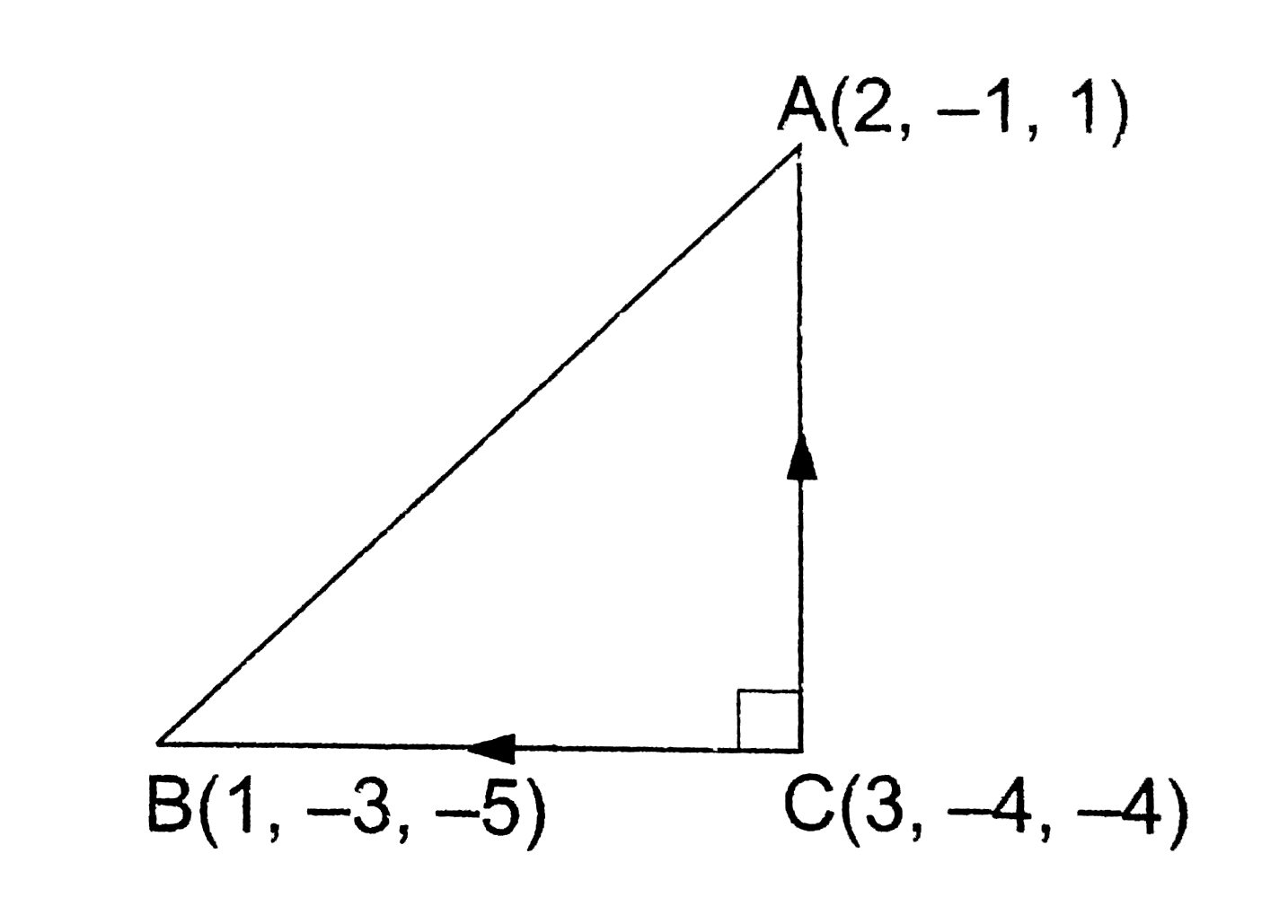Show that the points, A, B and C having position vectors (2ˆi−ˆj+ˆk),(ˆi−3ˆj−5ˆk) and (3ˆi−4ˆj−4ˆk) respectively are the vertices of a rightangled triangle. Also, find the remaining angles of the triangle.
We have
−−→AB=(p.v. of B)-(p.v. of A)
=(−ˆi−2ˆj−6ˆk),
−−→BC= (p.v. of C)-(p.v. of B)
=)2ˆi−ˆj+ˆk) and
−−→CA= (p.v. of A)-(p.v. of C)=(−ˆi+3ˆj+5ˆk).
Clearly, we have −−→AB+−−→BC+−−→CA=→0.
∴ A, B and C are the vertices of a triangle.
Now, −−→BC.−−→CA=(2ˆi−ˆj+ˆk).(−ˆi+3ˆj+5ˆk)=(−2−3+5)=0
∴−−→BC⊥−−→CA and therefore, ∠C=90∘.
Now, ∠A is the angle between −−→AB and −−→AC
∴−−→AB.−−→AC=∣∣∣−−→AB∣∣∣∣∣∣−−→AC∣∣∣cosA⇒cosA=(−−→AB.−−→AC)∣∣∣−−→AB∣∣∣∣∣∣−−→AC∣∣∣
=((-hat(i)-2hat(j)-6hat(k)).(hat(i)-3hat(j)-5hat(k)))/({sqrt((-1)^(2)+(-2)^(2)+(-6)^(2))}.{sqrt(1^(2)+(-3)^(2)+(-5)^(2))})<br>[ :' vec(AB)=-vec(CA)]<br>=((-1+6+30))/(sqrt(41)xxsqrt(35))=35/(sqrt(41)xxsqrt(35))=sqrt(35)/sqrt(41)=sqrt(35/41)<br>implies A= cos^(-1) sqrt(35/41)<br>Further,angleBisthe∠betweenvec(BC)andvec(BA)<br>:. vec(BC).vec(BA)=|vec(BC)||vec(BA)|cos B<br>implies cos B =((vec(BC).vec(BA)))/(|vec(BC)||vec(BA)|)<br>=((2hat(i)-hat(j)+hat(k)).(hat(i)+2hat(j)+6hat(k)))/({sqrt(2^(2)+(-1)^(2)+1^(2))}.{sqrt(1^(2)+2^(2)+6^(2))})<br>=((2-2+6))/(sqrt(6)xxsqrt(41))=6/(sqrt(6)xxsqrt(41))=sqrt(6)/sqrt(41)=sqrt(6/41)<br>implies B= cos^(-1) sqrt(6/41)<br>:. A=cos^(-1) sqrt(35/41), B= cos^(-1) sqrt(6/41),andC=90^(@).

Topper's Solved these Questions
- SCALAR, OR DOT, PRODUCT OF VECTORSBook:RS AGGARWALChapter:SCALAR, OR DOT, PRODUCT OF VECTORSExercise:Exercise 23
Explore 34 Videos
- RELATIONSBook:RS AGGARWALChapter:RELATIONSExercise:Objective Questions
Explore 22 Videos
- SOME SPECIAL INTEGRALSBook:RS AGGARWALChapter:SOME SPECIAL INTEGRALSExercise:Exercise 14C
Explore 26 Videos
Similar Questions
Show that the points A, B, C with position vectors 2ˆi−ˆj+ˆk, ˆi−3ˆj−5ˆk and 3ˆi−4ˆj−4ˆk respectively, are the vertices of a right angled triangle. Also, find the remaining angles of the triangle.
View SolutionShow that the points A,B,C with position vectors (3ˆi−2ˆj+4ˆk),(ˆi+ˆj+ˆk) and (−ˆi+4ˆj−2ˆk) respectively are collinear.
View Solution
Knowledge Check
The value of a, for which the points A, B, C with position vectors 2ˆi−ˆj+ˆk,ˆi−3ˆj−5ˆk,aˆi−3ˆj+ˆk respectively are the vertices of a right angled triangle with C=π2are
A1B2C-1D-2
Show that the points A, B and C with position vectors, →a=3ˆi−4ˆj−4ˆk, →b=2ˆi−ˆj+ˆkand →c=ˆi−3ˆj−5ˆk respectively form the vertices of a right angled triangle.
View SolutionShow that the four points A, B, C and D with position vectors 4ˆi+5ˆj+ˆk,−(ˆj+ˆk),3ˆi+9ˆj+4ˆk and 4(−ˆi+ˆj+ˆk) respectively are coplanar.
View Solutionshow that the points whose position vectors are (−2ˆi+3ˆj+5ˆk)
(ˆi+2ˆj+3ˆk) and (7ˆi−ˆk) are collinear.
View SolutionThe values of a for which the points A,B, and C with position vectors 2ˆi−ˆj+ˆk,ˆi−3ˆj−5ˆk, and aˆi−3ˆj+ˆk,respectively, are the vertices of a right-angled triangle with C=π2 are
View SolutionShow that the vectors ˆi−ˆj−6ˆk,ˆi−3ˆj+4ˆkand2ˆi−5ˆj+3ˆk are coplanar.
View SolutionShow that the points A, B, C with position vectors 2ˆi–ˆj+ˆk,ˆi–3ˆj–5ˆkand3ˆi–4ˆj–4ˆk respectively, are the vertices of a right-angled triangle. Hence find the area of the triangle.
View SolutionShow that the point A,B and C with position vectors →a =3ˆi - 4ˆj -4ˆk = 2ˆi j + ˆk and →c = ˆi - 3ˆj - 5ˆk , respectively from the vertices of a right angled triangle.
View Solution